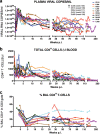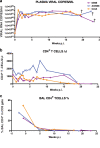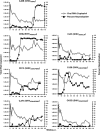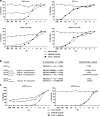Generation of the pathogenic R5-tropic simian/human immunodeficiency virus SHIVAD8 by serial passaging in rhesus macaques
- PMID: 20147396
- PMCID: PMC2863788
- DOI: 10.1128/JVI.02279-09
Generation of the pathogenic R5-tropic simian/human immunodeficiency virus SHIVAD8 by serial passaging in rhesus macaques
Abstract
A new pathogenic R5-tropic simian/human immunodeficiency virus (SHIV) was generated following serial passaging in rhesus macaques. All 13 animals inoculated with SHIV(AD8) passaged lineages experienced marked depletions of CD4(+) T cells. Ten of these infected monkeys became normal progressors (NPs) and had gradual losses of both memory and naïve CD4(+) T lymphocytes, generated antiviral CD4(+) and CD8(+) T cell responses, and sustained chronic immune activation while maintaining variable levels of plasma viremia (10(2) to 10(5) RNA copies/ml for up to 3 years postinfection [p.i.]). To date, five NPs developed AIDS associated with opportunistic infections caused by Pneumocystis carinii, Mycobacterium avium, and Campylobacter coli that required euthanasia between weeks 100 and 199 p.i. Three other NPs have experienced marked depletions of circulating CD4(+) T lymphocytes (92 to 154 cells/microl) following 1 to 2 years of infection. When tested for coreceptor usage, the viruses isolated from four NPs at the time of their euthanasia remained R5 tropic. Three of the 13 SHIV(AD8)-inoculated macaques experienced a rapid-progressor syndrome characterized by sustained plasma viremia of >1 x 10(7) RNA copies/ml and rapid irreversible loss of memory CD4(+) T cells that required euthanasia between weeks 19 and 23 postinfection. The sustained viremia, associated depletion of CD4(+) T lymphocytes, and induction of AIDS make the SHIV(AD8) lineage of viruses a potentially valuable reagent for vaccine studies.
Figures









Similar articles
-
SHIV-C109p5 NHP induces rapid disease progression in elderly macaques with extensive GI viral replication.J Virol. 2024 Feb 20;98(2):e0165223. doi: 10.1128/jvi.01652-23. Epub 2024 Feb 1. J Virol. 2024. PMID: 38299866 Free PMC article.
-
V3 loop-determined coreceptor preference dictates the dynamics of CD4+-T-cell loss in simian-human immunodeficiency virus-infected macaques.J Virol. 2005 Oct;79(19):12296-303. doi: 10.1128/JVI.79.19.12296-12303.2005. J Virol. 2005. PMID: 16160156 Free PMC article.
-
Pathogenicity and mucosal transmissibility of the R5-tropic simian/human immunodeficiency virus SHIV(AD8) in rhesus macaques: implications for use in vaccine studies.J Virol. 2012 Aug;86(16):8516-26. doi: 10.1128/JVI.00644-12. Epub 2012 May 30. J Virol. 2012. PMID: 22647691 Free PMC article.
-
Understanding the basis of CD4(+) T-cell depletion in macaques infected by a simian-human immunodeficiency virus.Vaccine. 2002 May 6;20(15):1934-7. doi: 10.1016/s0264-410x(02)00072-5. Vaccine. 2002. PMID: 11983249 Review.
-
Stepping toward a macaque model of HIV-1 induced AIDS.Viruses. 2014 Sep 25;6(9):3643-51. doi: 10.3390/v6093643. Viruses. 2014. PMID: 25256394 Free PMC article. Review.
Cited by
-
Delayed vaginal SHIV infection in VRC01 and anti-α4β7 treated rhesus macaques.PLoS Pathog. 2019 May 13;15(5):e1007776. doi: 10.1371/journal.ppat.1007776. eCollection 2019 May. PLoS Pathog. 2019. PMID: 31083697 Free PMC article.
-
Most rhesus macaques infected with the CCR5-tropic SHIV(AD8) generate cross-reactive antibodies that neutralize multiple HIV-1 strains.Proc Natl Acad Sci U S A. 2012 Nov 27;109(48):19769-74. doi: 10.1073/pnas.1217443109. Epub 2012 Nov 5. Proc Natl Acad Sci U S A. 2012. PMID: 23129652 Free PMC article.
-
Sequential immunization of macaques elicits heterologous neutralizing antibodies targeting the V3-glycan patch of HIV-1 Env.Sci Transl Med. 2021 Nov 24;13(621):eabk1533. doi: 10.1126/scitranslmed.abk1533. Epub 2021 Nov 24. Sci Transl Med. 2021. PMID: 34818054 Free PMC article.
-
HIV-1 escapes from N332-directed antibody neutralization in an elite neutralizer by envelope glycoprotein elongation and introduction of unusual disulfide bonds.Retrovirology. 2016 Jul 7;13(1):48. doi: 10.1186/s12977-016-0279-4. Retrovirology. 2016. PMID: 27388013 Free PMC article.
-
Rhesus macaques show increased resistance to repeated SHIV intrarectal exposure following a heterologous regimen of rVSV vector vaccine expressing HIV antigen.Emerg Microbes Infect. 2023 Dec;12(2):2251595. doi: 10.1080/22221751.2023.2251595. Emerg Microbes Infect. 2023. PMID: 37649434 Free PMC article.
References
-
- Amara, R. R., F. Villinger, J. D. Altman, S. L. Lydy, S. P. O'Neil, S. I. Staprans, D. C. Montefiori, Y. Xu, J. G. Herndon, L. S. Wyatt, M. A. Candido, N. L. Kozyr, P. L. Earl, J. M. Smith, H. L. Ma, B. D. Grimm, M. L. Hulsey, J. Miller, H. M. McClure, J. M. McNicholl, B. Moss, and H. L. Robinson. 2001. Control of a mucosal challenge and prevention of AIDS by a multiprotein DNA/MVA vaccine. Science 292:69-74. - PubMed
-
- Barnett, S. W., I. K. Srivastava, E. Kan, F. Zhou, A. Goodsell, A. D. Cristillo, M. G. Ferrai, D. E. Weiss, N. L. Letvin, D. Montefiori, R. Pal, and M. Vajdy. 2008. Protection of macaques against vaginal SHIV challenge by systemic or mucosal and systemic vaccinations with HIV-envelope. AIDS 22:339-348. - PubMed
-
- Barouch, D. H., S. Santra, J. E. Schmitz, M. J. Kuroda, T. M. Fu, W. Wagner, M. Bilska, A. Craiu, X. X. Zheng, G. R. Krivulka, K. Beaudry, M. A. Lifton, C. E. Nickerson, W. L. Trigona, K. Punt, D. C. Freed, L. Guan, S. Dubey, D. Casimiro, A. Simon, M. E. Davies, M. Chastain, T. B. Strom, R. S. Gelman, D. C. Montefiori, M. G. Lewis, E. A. Emini, J. W. Shiver, and N. L. Letvin. 2000. Control of viremia and prevention of clinical AIDS in rhesus monkeys by cytokine-augmented DNA vaccination. Science 290:486-492. - PubMed
-
- Brenchley, J. M., T. W. Schacker, L. E. Ruff, D. A. Price, J. H. Taylor, G. J. Beilman, P. L. Nguyen, A. Khoruts, M. Larson, A. T. Haase, and D. C. Douek. 2004. CD4+ T cell depletion during all stages of HIV disease occurs predominantly in the gastrointestinal tract. J. Exp. Med. 200:749-759. - PMC - PubMed
Publication types
MeSH terms
Substances
Grants and funding
LinkOut - more resources
Full Text Sources
Other Literature Sources
Molecular Biology Databases
Research Materials

